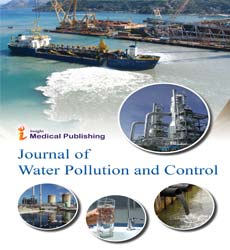Sewage Treatment and Merchandising Untreated Waste Endangers Thousands of Poor People
Rabia Taylor*
Managing editor, Journal of Water Pollution and Control, London, UK
- *Corresponding Author:
- Rabia Taylor
Managing editor
Journal of Water Pollution and Control
London, UK
E-mail: lora456@hotmail.com
Received Date: May 02, 2021; Accepted Date: May 17, 2021; Published Date: May 24, 2021
Citation: Taylor R (2021) Sewage Treatment and Merchandising Untreated Waste Endangers Thousands of Poor People. J Water Pollut Control. Vol. 3 No. 3:14.
Introduction
Waste product water is the waste water that flows after it has been used for a variety of purposes, including domestic, industrial, and other purposes. In today's cities, waste product contamination may even be a major drawback. Water-related disorders affect around 2.3 billion people on the planet. Sewage pollution enters our local waterways when it exits the system due to an overflow, spill, or breach in the sanitary sewer collection system. Morbific protozoa such as flagellate protozoan and Cryptosporium can be found in waste products, posing a health concern to humans. The use of contaminated waste products as a source of chemical could result in epidemics of diseases such as infectious disease. The Republic of India has approximately 300 waste product treatment plants, the most of which are underutilised and poorly located. We must constantly analyse how well we are treating our waste water and preventing waste product outflow into our bordering stream.
Waste Water Pollution and its Causes
Sewage pollution is one in all the foremost issues in cities. Improper handling of waste water is that the foremost reason behind the pollution of water. The careless disposal of waste product water ends up in a sequence of issues, like spreading of diseases, eutrophication, increase in Biological atomic number 8 Demand Biological Oxygen Demand (BOD), etc. Following are vital causes of waste product pollution.
• Raw or partially-treated waste product overflow, spill, or unharness from a hygienically sewer assortment system
• Tree roots, oils, and dust in waste products clog pipes
• The sewer lines, whether private or public, are cracked
• Sewer infrastructure that is ageing will increase the frequency and severity of spills
• Overflows generated by fresh water entering the sewer system through pipe defects or unauthorised connections, exceeding the system's capacity
• Cracked or damaged inspection holes in the mains facility will allow water to enter the sewerage system. Effects of waste product water on the environment
• Using untreated waste product water puts human health and other living organisms at risk
• Waste contains salts, which can build up in the premise zone and have negative effects on soil health and agricultural output
• The application of waste material has the potential to degrade the quality of groundwater resources to levels that are among the highest of the day due to excess nutrients and salts
• If voidance water drains extensively into bodies of water and surface water, nutrient residues could induce eutrophication
How Pollution from Waste Products can be Removed from Neighbourhood
Sewer backups and spills pose a health risk, damage to home interiors, and a threat to the environment. Once waste products depart the installation, they pollute our local streams. The techniques below will assist you in reducing wastewater overflow in your motel or area.
• Even the tiniest cracks in pipes will be invaded by tree roots. Tree roots will clog sewer systems, causing backups and overflows. Things of thirsty trees should be treated with care
• Catch food scraps in sink baskets/strainers and dispose of them in the garbage
• It is necessary to urge the repair or replacement of cracked pipes
Open Access Journals
- Aquaculture & Veterinary Science
- Chemistry & Chemical Sciences
- Clinical Sciences
- Engineering
- General Science
- Genetics & Molecular Biology
- Health Care & Nursing
- Immunology & Microbiology
- Materials Science
- Mathematics & Physics
- Medical Sciences
- Neurology & Psychiatry
- Oncology & Cancer Science
- Pharmaceutical Sciences
